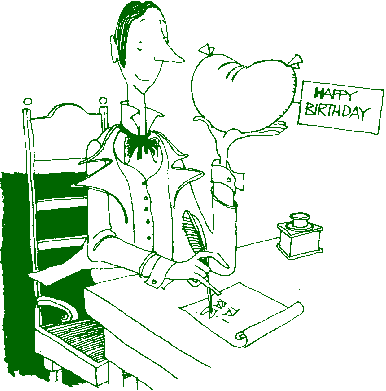Burns Suppers
 Each year the Society holds its own Burns Supper for members and
their guests (maximum three guests per member). They are
memorable occasions with first-rate speakers, properly run but
not solemn. Cars are left at home... Bear in mind that numbers
are limited to sixty by the size of the room.
Each year the Society holds its own Burns Supper for members and
their guests (maximum three guests per member). They are
memorable occasions with first-rate speakers, properly run but
not solemn. Cars are left at home... Bear in mind that numbers
are limited to sixty by the size of the room.
The first recorded Burns Supper was held a mere five years
after the poet's death, in the summer of 1801. Then, as now, its
purpose was to recollect and celebrate his life and work. The
venue was Burns Cottage in Alloway, which was an ale-house at
that time; present were nine of Burns' closest friends; a
commemorative speech was given; haggis was served. It was
determined that future annual suppers should be held on Burns'
birthday, which was erroneously thought to be January 29th (in
fact it was four days earlier).
By 1810 the nine friends had been joined by many others and
were known as the Alloway Burns Club. Other clubs sprang up in
Greenock, Paisley and Kilmarnock, and by 1830 Burns Suppers were
widespread all over Scotland. Today, the Burns Federation, based
in Kilmarnock, lists nearly 400 affiliated clubs throughout the
world.
The programme at Burns Suppers varies only slightly from one
to another. When the company is seated, the evening's Chairman
says a few words of welcome and then recites The Selkirk Grace
(or calls upon a clergyman to do so, if one is present).
Cock-a-leekie soup is served. Then comes the haggis (served
with 'champit tatties' and 'bashed neeps' or 'clapshot' (i.e.
mashed potatoes and mashed turnips/turnips and carrots'). It is
borne in on an ashette, preceded by a piper, and (traditionally)
followed by someone carrying two bottles of whisky. Having
processed round the room the haggis is placed before the
Chairman, who invites the piper to join him in a glass of whisky,
and pours some over the haggis itself. [It is customary, and
sensible, to drink whisky throughout the meal, by the way]. They
raise their glasses in the Gaelic toast slainte mhath and drain
them. I once attended a smart Burns Supper in Aberdeenshire,
where the piper toppled over as he drained his glass and fell
upon the haggis itself, dead drunk! Then either the Chairman or a
nominated guest recites Burns immortal address To a Haggis.
It is customary at some dinners to serve a main course
(usually roast beef) after the haggis, but purists frown on this.
A traditional dessert like 'Tipsy Laird' (sherry trifle) or
'Cranachan' (cream with whisky, heather honey, oatmeal and soft
fruits) is then presented, and possibly Scottish cheese and
oatcakes. The Loyal Toast concludes the meal.
Now come the speeches. First, following, a brief intermission
and an introduction by the Chairman, is 'The Immortal Memory'.
This can be light-hearted and humourous or seriously literary,
but, as one expert puts it "the speeches have one aim in
common: to make everyone in the room want to go home and read
Burns" (Nancy Marshall).
After the Immortal Memory there is often a musical interlude,
usually on the pipes, then a short 'Appreciation' of the last
speech is delivered, either by the Chairman or a guest. This is
followed by the two other 'compulsory' speeches: 'The Toast to
the Lasses' and 'The Reply'.
The Toast to the Lasses was originally merely a vote of
thanks to the ladies who had prepared the food for the evening.
Today it is usually a humourous and somewhat disrespectful
observation on the Fair Sex. The Reply, which is delivered by a
woman, turns the tables, detailing mens' lack of virtue. Both
speeches should draw inspiration from The Bard.
Other toasts can follow - a common one is 'The Toast to the
[Scottish] Nation', which will be included in the Society's
Supper programme. Various songs and recitations from Burns' work
follow, or intersperse, the speeches.
"At this point", concludes one Guide to Burns
Suppers, "unless a dance is planned for the rest of the
evening, the supper draws to a close and the guests depart having
thoroughly enjoyed a unique and uplifting occasion". Quite
so.
Unless otherwise noted, all information in this site © The Scotch Malt Whisky Society, Edinburgh, Scotland, 1997.
 Each year the Society holds its own Burns Supper for members and
their guests (maximum three guests per member). They are
memorable occasions with first-rate speakers, properly run but
not solemn. Cars are left at home... Bear in mind that numbers
are limited to sixty by the size of the room.
Each year the Society holds its own Burns Supper for members and
their guests (maximum three guests per member). They are
memorable occasions with first-rate speakers, properly run but
not solemn. Cars are left at home... Bear in mind that numbers
are limited to sixty by the size of the room.